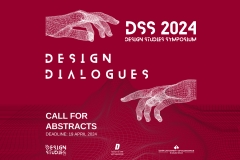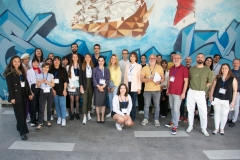
GRADUATE SCHOOL
Ph.D. In Design Studies
FFD 661 | Course Introduction and Application Information
| Course Name |
Art, Science and Design
|
|
Code
|
Semester
|
Theory
(hour/week) |
Application/Lab
(hour/week) |
Local Credits
|
ECTS
|
|
FFD 661
|
Fall/Spring
|
3
|
0
|
3
|
7.5
|
| Prerequisites |
None
|
|||||
| Course Language |
English
|
|||||
| Course Type |
Elective
|
|||||
| Course Level |
Third Cycle
|
|||||
| Mode of Delivery | - | |||||
| Teaching Methods and Techniques of the Course | DiscussionCase StudyQ&ACritical feedbackLecture / Presentation | |||||
| Course Coordinator | ||||||
| Course Lecturer(s) | ||||||
| Assistant(s) | - | |||||
| Course Objectives | The aim of this course is to explore new possibilities in design research, theory, and discourse through a dialogue between design, science, and art. |
| Learning Outcomes |
The students who succeeded in this course;
|
| Course Description | This course has been designed to offer new insight into design research in response to growing interest in interdisciplinary possibilities within the art-design-science triangle. Critical readings, discussions, educational material preparation, and short-term design research projects will be the main educational tools for the course. |
|
|
Core Courses |
X
|
| Major Area Courses | ||
| Supportive Courses | ||
| Media and Management Skills Courses | ||
| Transferable Skill Courses |
WEEKLY SUBJECTS AND RELATED PREPARATION STUDIES
| Week | Subjects | Related Preparation |
| 1 | Introduction to the Course | No Preparation |
| 2 | Art and Architecture | Architectural Design, Vol. 73 No.3 May/June 2003 |
| 3 | Design and Science/Is Design Art or Science? | The Neri Oxman Material Ecology Catalogue/Cross, Nigel (2001) "Designerly Ways of Knowing: Design Discipline versus Design Science" Design Issues Vol 17 No 3, pp 49-55. |
| 4 | Digital Arts, Crafts, and Design | Shillito – Digital Crafts |
| 5 | Designers’ Work in Museums Architecture of Art Museums | Centre Georges Pompidou Museum Guide |
| 6 | Graphic Design vs Visual Art | Frascara, J. (1988). Graphic design: Fine art or social science?. Design issues, 5(1), 18-29. |
| 7 | Mathematics and Fashion Design Mathematics and Architecture | Mathematics and Fashion Design Mathematics and Architecture |
| 8 | Design vs Engineering Design | Presentation |
| 9 | Biology + Design = Biodesign | The rise of biodesign : contemporary research methodologies for nature-inspired design in China |
| 10 | Midterm | All presentation materials |
| 11 | Student Presentations | Literature search, presentation materials |
| 12 | Student Presentations | Literature search, presentation materials |
| 13 | Student Presentations | Literature search, presentation materials |
| 14 | Student Presentations | Literature search, presentation materials |
| 15 | Term Paper discussions and critique | Individual study and research |
| 16 | Term Paper Final Review | Submission |
| Course Notes/Textbooks | - |
| Suggested Readings/Materials | Antonelli, P. (2020) The Neri Oxman Material Ecology Catalogue, The Museum of Modern Art, New York Architectural Design, Vol. 73 No.3 May/June 2003 Cross, N. (2001) "Designerly Ways of Knowing: Design Discipline versus Design Science" Design Issues Vol 17 No 3, pp 49-55. Frascara, J. (1988). Graphic design: Fine art or social science?. Design issues, 5(1), 18-29. Polites, M. (2019). The rise of biodesign : contemporary research methodologies for nature-inspired design in China, Tongji University Press, Shanghai Shillito, A.M. (2013) Digital Crafts, Bloomsbury Myers, W. (2018). Bio Design. Nature, Science, Creativity. Thames & Hudson |
EVALUATION SYSTEM
| Semester Activities | Number | Weigthing |
| Participation | ||
| Laboratory / Application | ||
| Field Work | ||
| Quizzes / Studio Critiques | ||
| Portfolio | ||
| Homework / Assignments |
|
24
|
| Presentation / Jury |
2
|
16
|
| Project |
2
|
60
|
| Seminar / Workshop | ||
| Oral Exams | ||
| Midterm | ||
| Final Exam | ||
| Total |
| Weighting of Semester Activities on the Final Grade |
5
|
100
|
| Weighting of End-of-Semester Activities on the Final Grade | ||
| Total |
ECTS / WORKLOAD TABLE
| Semester Activities | Number | Duration (Hours) | Workload |
|---|---|---|---|
| Theoretical Course Hours (Including exam week: 16 x total hours) |
16
|
3
|
48
|
| Laboratory / Application Hours (Including exam week: '.16.' x total hours) |
16
|
0
|
|
| Study Hours Out of Class |
4
|
4
|
16
|
| Field Work |
0
|
||
| Quizzes / Studio Critiques |
0
|
||
| Portfolio |
0
|
||
| Homework / Assignments |
3
|
4
|
12
|
| Presentation / Jury |
2
|
6
|
12
|
| Project |
2
|
65
|
130
|
| Seminar / Workshop |
0
|
||
| Oral Exam |
0
|
||
| Midterms |
10
|
0
|
|
| Final Exam |
0
|
||
| Total |
218
|
COURSE LEARNING OUTCOMES AND PROGRAM QUALIFICATIONS RELATIONSHIP
|
#
|
Program Competencies/Outcomes |
* Contribution Level
|
||||
|
1
|
2
|
3
|
4
|
5
|
||
| 1 | to be able to develop scientific expertise and capabilities in the field of design studies by using creative and critical thinking as well as research skills; innovatively contributing to the discipline through new ideas, |
X | ||||
| 2 | to be able to comprehend the interaction across various disciplines related to the field of design reaching at original conclusions via using new and complex analysis, synthesis and evaluation skills, |
X | ||||
| 3 | to be able to develop new strategic approaches to solve unforeseen complex issues in design practice through integrative and creative elaboration, |
X | ||||
| 4 | to be able to conduct independent research, analyze scientific phenomena through a broad, deep and critical perspective, arrive at new syntheses and evaluations in design discipline, |
X | ||||
| 5 | to be able to publish scientific articles in reputable refereed journals, present papers in scientific conferences in the field of design and its sub-disciplines, |
|||||
| 6 | to be able to develop effective communication skills to scientifically present and defend original ideas to an expert audience, |
X | ||||
| 7 | to be able to conduct affective team work in the field of design, |
|||||
| 8 | to be able to use the English language fluently for both comprehending scientific publications and developing proper communication with foreign colleagues, |
X | ||||
| 9 | to be able to contribute to the process of transforming into an " information society", by following the technological, social and cultural developments on both academic and professional grounds continuously, |
|||||
| 10 | to be able to develop skills of designing and producing unique models and products that will be certificated as registered design, trade mark and patents. |
|||||
*1 Lowest, 2 Low, 3 Average, 4 High, 5 Highest
NEWS |ALL NEWS

DSS 2024 CALL FOR PAPERS | THEME: DESIGN DIALOGUES
DSS 2024 CALL FOR PAPERS THEME: DESIGN DIALOGUES The Design Studies Graduate Program and the Faculty of Fine Arts and Design at the Izmir

Design Studies Symposium 2023: Realities & Frontiers
The Design Studies Symposium 2023 (DSS 2023) organized by the IEU Graduate School Design Studies programs was held on 1-2 June, at




